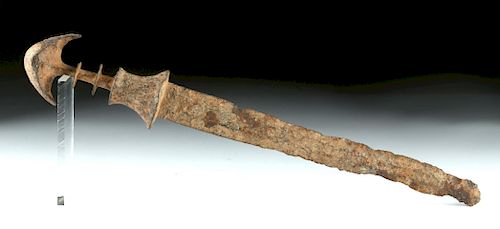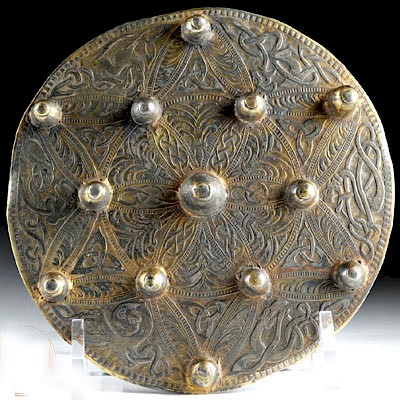Rare Luristan Iron Short Sword
Lot 55a
About Seller
Artemis Fine Arts
686 S Taylor Ave, Ste 106
Louisville, CO 80027
United States
Selling antiquities, ancient and ethnographic art online since 1993, Artemis Gallery specializes in Classical Antiquities (Egyptian, Greek, Roman, Near Eastern), Asian, Pre-Columbian, African / Tribal / Oceanographic art. Our extensive inventory includes pottery, stone, metal, wood, glass and textil...Read more
Estimate:
$1,500 - $2,500
Absentee vs Live bid
Two ways to bid:
- Leave a max absentee bid and the platform will bid on your behalf up to your maximum bid during the live auction.
- Bid live during the auction and your bids will be submitted real-time to the auctioneer.
Bid Increments
| Price | Bid Increment |
|---|---|
| $0 | $25 |
| $300 | $50 |
| $1,000 | $100 |
| $2,000 | $250 |
| $5,000 | $500 |
| $10,000 | $1,000 |
| $20,000 | $2,500 |
| $50,000 | $5,000 |
| $100,000 | $10,000 |
| $200,000 | $20,000 |
About Auction
By Artemis Fine Arts
Jul 19, 2018
Set Reminder
2018-07-19 10:00:00
2018-07-19 10:00:00
America/New_York
Bidsquare
Bidsquare : Fine Antiquities/Ethnographic Art
https://www.bidsquare.com/auctions/artemis-gallery/fine-antiquities-ethnographic-art-3329
Featuring classical antiquities, ancient and ethnographic art from cultures encompassing the globe, plus fine art. Artemis Fine Arts info@artemisgallery.com
Featuring classical antiquities, ancient and ethnographic art from cultures encompassing the globe, plus fine art. Artemis Fine Arts info@artemisgallery.com
- Lot Description
Ancient Near East, Luristan, ca. 1100 BCE. A short iron sword with a triangular blade marked by a broad, flat midrib and an elaborate handle - a crescent-shaped pommel above a wide guard, with two paper-thin iron discs between them, presumably to wrap leather around to form a comfortable grip. Luristan is famous for its bronzework, but its blacksmiths produced some of the oldest known iron decorated tools and weaponry in the world. Partly this seems to have been in imitation of the bronzework; hence the incredibly-shaped handle here. This is remarkable, because iron is a much less tractable metal to work with compared to bronze, and items like this sword had to be laboriously made from many separate pieces of low-carbon iron. Based on similar swords from the area, the bulbous shapes at the top of the handle may actually be degraded forms of lion couchants; the overhanging edges might once have had grotesque human faces on them. Size: 2.45" W x 15.3" H (6.2 cm x 38.9 cm)
It seems that these pieces were made not to be used in battle, but instead to show status or as votive weapons. There is a strong tradition in the ancient Near East of swords and other weapons being associated with the gods. For example, there is a rock carving dating to ca. 1300 BCE from this region that shows a scene of the gods of the Underworld, including one who is holding a sword similar to this one. Similarly, a golden bowl excavated at Hasanlu shows three swords of similar form to this one that are associated with three deities from the Hittite pantheon. Whatever its original function, this would have been a spectacular weapon to behold; iron objects from this time period are extremely rare, especially ones as decorated as this. The gleaming surface would have been even more interesting to see than bronze, the most common prestige metal of the time. Whoever commissioned the making of this sword must have been a high status individual, perhaps seeking to honor their gods by handling such a weapon.
Provenance: ex-private United Kingdom collection
All items legal to buy/sell under U.S. Statute covering cultural patrimony Code 2600, CHAPTER 14, and are guaranteed to be as described or your money back.
A Certificate of Authenticity will accompany all winning bids.
We ship worldwide and handle all shipping in-house for your convenience.
#136265Fine oxidized patina that does not obscure the form. Blade tip is lost and edges have some small losses, but for ancient iron, this is in a great state of preservation.Condition
- Shipping Info
-
All shipping is handled in-house for your convenience. Your invoice from Artemis Gallery will include shipping calculation instructions. If in doubt, please inquire BEFORE bidding for estimated shipping costs for individual items.
-
- Buyer's Premium



 EUR
EUR CAD
CAD AUD
AUD GBP
GBP MXN
MXN HKD
HKD CNY
CNY MYR
MYR SEK
SEK SGD
SGD CHF
CHF THB
THB














